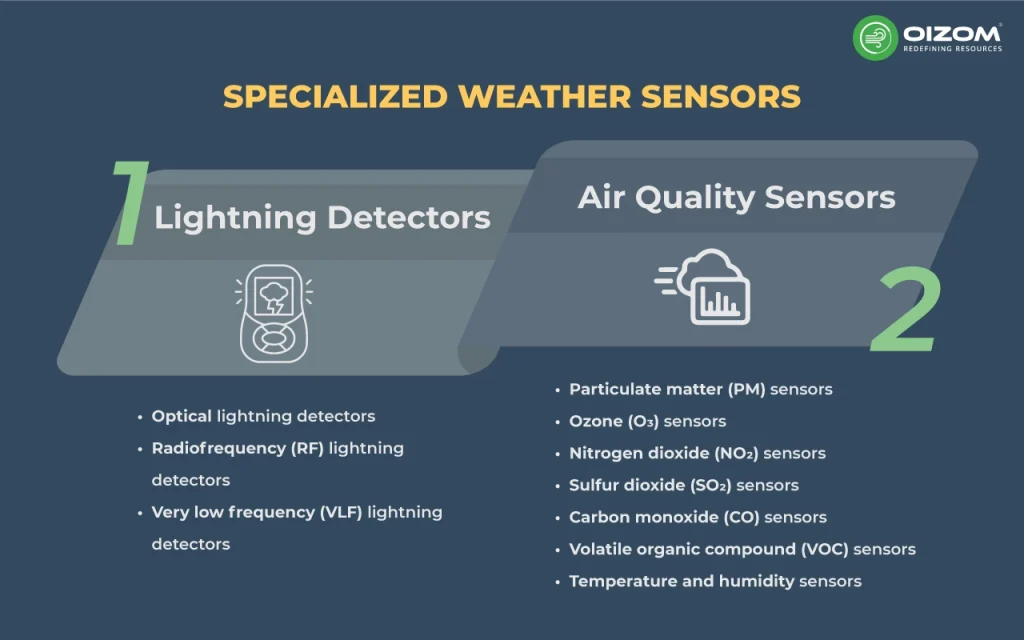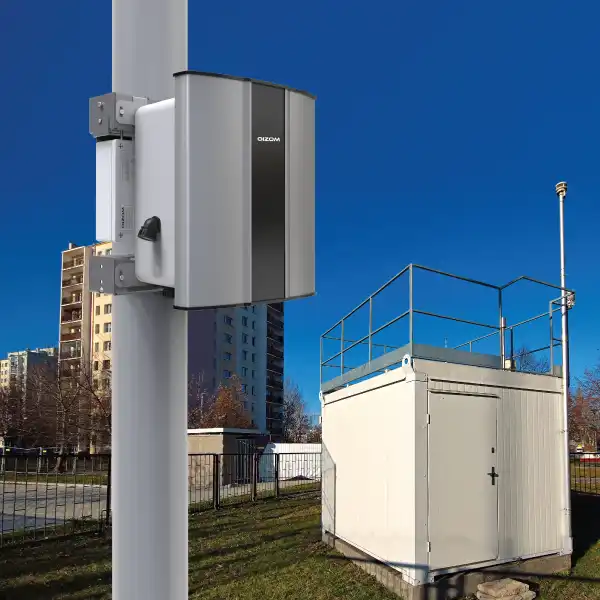Key Takeaways
- Real-Time Data: Weather sensors provide precise, real-time data on temperature, humidity, pressure, wind speed, and direction, improving forecasting accuracy.
- Cloud Integration: Data collected by weather sensors can be uploaded to cloud platforms, enabling easy access to real-time and historical weather information.
- Meteorological Sensors: These sensors measure essential atmospheric parameters, supporting weather forecasting, climate research, and environmental monitoring.
- Specialized Sensors: Advanced sensors, such as lightning detectors and air quality monitors, provide detailed data on specific atmospheric conditions, enhancing safety and environmental health.
- Air Quality Sensors: Sensors like particulate matter (PM), ozone, and nitrogen dioxide detectors measure pollutants, providing crucial data for public health and environmental monitoring.
- IoT Integration: Integrating IoT technology in weather monitoring systems enhances data accuracy, reliability, and ease of access through interconnected devices.
- Environmental Protection: Data from weather and air quality sensors support environmental protection efforts by monitoring pollution levels and aiding in regulatory compliance.
- Industry Applications: Industries rely on precise weather data for operational planning, safety measures, and optimizing processes affected by atmospheric conditions.
Which sensor is used for weather monitoring? Understanding its importance.
Imagine waking up in the morning, sipping your coffee, and getting ready for work. You look out the window and see heavy clouds rolling in. You might wonder if you should go to the office or work from home. You’re curious about how the weather will affect your day. This is where various sensors in IoT weather monitoring systems come into the picture. As technology advances, these sensors are becoming more precise and advanced, improving weather monitoring reliability and efficiency.
Meteorological sensors are devices designed to measure and monitor meteorological elements. It can measure various meteorological factors, such as temperature, humidity, barometric pressure, wind speed, wind direction, precipitation, etc., and provides accurate meteorological data to support weather forecasting, climate research, environmental monitoring, and other sectors. In my previous blog, I explained the benefits of IoT weather monitoring systems. In this blog, I’ll give you an overview of the different sensors used in these systems to monitor weather conditions.
Role of sensors in weather monitoring
Before we dive deeper, let’s understand what weather sensors are and what they do. A weather sensor is a device that measures and monitors meteorological conditions, such as temperature, humidity, barometric pressure, precipitation, wind speed and direction, soil moisture, and solar radiation. The primary purpose of weather sensors is to collect and record data on atmospheric conditions to understand better and predict weather changes.
These weather sensors can be used almost anywhere, from large-scale weather stations to your personal weather monitoring systems. Now, you might be thinking, “Isn’t there an app for that?” Sure, there are plenty of weather apps, but here’s the catch: those apps probably won’t give you the exact weather for your specific location. That’s where these sensors come in. They provide accurate, real-time data about the weather right where you are, plus many other interesting insights. So, if you’ve got renewable energy setups like solar or wind, or if you just need detailed weather info for your area, these sensors are perfect for you.
Common Weather Sensors
Temperature, humidity, atmospheric pressure, wind, soil, and other relevant sensors are some of the most common weather sensors used to measure and monitor essential atmospheric parameters. Here is a brief description of them:
Temperature Sensors
- Sensors are used to measure air temperature. Common types include resistance thermometers (RTDs), thermocouples, and semiconductor temperature sensors.
- A temperature sensor is a device that can measure the temperature in the atmosphere. It typically consists of a sensitive element (e.g., thermistor, thermocouple) and a signal processing unit. The sensitive element of the temperature sensor can detect temperature changes in the atmosphere and convert them into an electrical or digital signal, which is subsequently amplified, filtered, linearized, and so on by the signal processing unit, resulting in readable measurement data. Temperature sensors are frequently used in weather stations, satellites, and other weather monitoring systems.
Humidity Sensors
- In outdoor weather monitoring, temperature and humidity sensors are one of the most basic measurement elements. The sensor is used to determine the moisture content of atmospheric humidity. The two most prevalent types of humidity sensors are capacitive and resistive.
- A humidity sensor is a device that can measure humidity in air or water vapor content of the atmosphere. It typically consists of a sensitive element (e.g., moisture-sensitive resistor, hygroscopic agents, moisture-sensitive capacitor, piezoelectric elements, etc.) and a signal processing unit. The sensitive element of the humidity sensor detects changes in water vapor content in the atmosphere and converts it into an electrical or digital signal, which then passes through the signal processing unit for amplification, filtering, linearization, and other processing before being output as readable measurements.
- Humidity sensors are important for applications such as predicting precipitation, determining cloud formation, and agricultural irrigation.
Atmospheric Pressure Sensors
- Atmospheric pressure sensors monitor air pressure or atmospheric pressure in the atmosphere. Common types include piezoresistive sensors and piezoelectric sensors.
- They commonly use piezoresistive or piezoelectric sensors to detect air pressure changes. Atmospheric pressure sensors play an important role in weather forecasting, climate research, and aeronautics, among other areas.
- Data from these sensors can be wirelessly or wired to weather stations, data loggers, and other data processing devices for analysis, research, and forecasting. Together, they produce reliable measurements of atmospheric conditions and basic data for weather forecasting, climate research, and other related applications.
Wind Speed and Direction Sensors
- These sensors measure the speed of the wind. Common types include cup wind speed sensors, ultrasonic wind speed sensors, and hot wire wind speed sensors. The primary function of wind speed sensors is to measure wind speed in the atmosphere and convert it to an electrical signal.
- Rotating wind speed sensors typically have a revolving rod or vane that spins with the wind. The wind speed can be estimated by measuring either the speed or angle of rotation. They are widely utilized in applications like weather stations and wind farms.
- Ultrasonic wind speed sensors use ultrasonic technology to determine wind speed. They calculate wind speed by emitting ultrasonic signals and measuring their propagation duration and direction. Because of their excellent accuracy and quick response time, ultrasonic wind sensors are used in aviation, meteorology, and maritime applications.
- Hot-wire wind speed sensors measure wind speed by using hot wires’ heat dissipation capabilities. They typically have one or more heating wires, and when the wind blows, the wind speed is determined by measuring the degree of cooling of the heating wires. Hot-wire wind speed sensors are frequently utilized in applications such as weather stations and air conditioning systems.
- Data from wind speed sensors can be combined with observations of other meteorological parameters such as temperature, humidity, and air pressure to produce more complete weather information. These data are critical for weather forecasting, climate research, air navigation, and wind energy use.
Precipitation Sensors
- A sensor for measuring precipitation. Common types include rain gauges, liquid stream gauges, and optical precipitation sensors.
- A rain gauge is a sensor that measures the amount of precipitation. It properly detects rainfall and assists meteorologists, farmers, and other industry professionals with weather monitoring and water management.
There are several common types of rain gauges:
- Cylinder rain gauges are among the most popular and traditional types of rain gauges. They have a cylindrical glass measuring cylinder and a funnel. When it rains, the rainwater flows through the funnel and into the measuring cylinder, thereby determining the amount of rainfall. The cylinder is labeled with a scale, allowing you to read the amount of rainfall directly.
- The tipping bucket rain gauge is a gadget that automatically measures the amount of rain. It includes a funnel and a tipping bucket. When it rains, it travels down the funnel and into the tipping bucket, which rolls over and records the rainfall when it reaches a specified level. This sort of rain gauge is typically equipped with a data logger, which enables continuous recording of rainfall data over time.
- Radar rain gauges use radar technology to measure rainfall. It determines the location and intensity of rainfall by sending out radar beams and receiving reflected signals. This gauge can track rainfall over a large region in real time and produce rainfall images and statistics.
- Optical rain gauges use optical sensors to detect rainfall. They detect and count droplets by scattering and reflecting light beams to determine the amount of rainfall. Optical rain gauges are often distinguished by rapid reaction and high accuracy.
Solar Radiation Sensors
- Solar radiation sensors monitor the sun’s ability to emit radiation. They are widely used in meteorology, environmental monitoring, and renewable energy applications.
- Solar radiation sensors typically operate using photosensitive elements such as silicon photocells or thermocouples. These elements are extremely sensitive to the sun’s radiative power, and when the sun’s rays strike the element’s surface, they cause a current or temperature change. By sensing and converting these changes, the sensor can provide accurate solar radiation data.
Applications for solar radiation sensors include, but are not limited to, the following:
- Meteorological monitoring: solar radiation sensors can detect the intensity of solar and UV radiation, allowing meteorologists to forecast weather changes and climate trends.
- Renewable energy: Solar radiation sensors measure the sun’s radiation capacity and give data support for equipment like solar panels or water heaters, resulting in more effective use of solar energy.
- Environmental monitoring: Solar radiation sensors can track solar radiation in the environment, providing information for urban planning. For example, they can assess the impact of heat islands on various parts of a city.
- Building design: Solar radiation sensors can help architects determine the orientation and window design of buildings to maximize the use of natural light and heat.
Soil Moisture Sensors
- The soil moisture sensor is primarily used to measure soil volumetric water content, which can then be utilized for soil moisture monitoring, agricultural irrigation, and forestry management.
- The soil moisture sensor comprises a stainless steel probe and a waterproof enclosure. It can be buried in soil and used for an extended period of time to monitor the moisture content of both the surface and deep soil.
- When combined with a data collector, it can be used for both fixed-point monitoring and mobile moisture measurement. Furthermore, the soil moisture sensor can be equipped with temperature and conductivity modules, allowing it to monitor soil temperature, moisture, and conductivity simultaneously.
- Predicting changes in soil moisture allows farmers to decide whether to increase tilling to improve soil drainage or reduce it to conserve water in the soil.
- In addition, a soil moisture forecast is essential for deciding on fertilizer timing and delivery. With favorable soil conditions, fertilizers penetrate the soil more effectively, while overly moist soil causes them to be washed away, wasting money and resources.
Specialized Weather Sensors

- Specialized weather sensors are sophisticated instruments that measure specific atmospheric conditions. These sensors go beyond basic weather characteristics such as temperature and humidity to provide accurate data for various applications.
- For example, lightning detectors monitor electrical activity in the atmosphere, which is critical for early warning systems. Air quality sensors monitor pollutants such as ozone, nitrogen dioxide, and particle matter to assess environmental conditions. Meteorological sensors monitor wind speed, direction, pressure, precipitation, and sun radiation, which are critical for weather forecasting and climate research.
- These specialized sensors are critical to industries such as aviation, agriculture, and environmental monitoring. They give vital information for analyzing weather trends, forecasting extreme events, and making informed decisions.
Lightning Detectors
Lightning sensors detect lightning, as their name suggests. However, there’s so much more to lightning than just whether or not it’s happening. Where exactly are the strikes taking place?
Lightning detectors are specialized tools for detecting and monitoring lightning activity. They are key in early warning systems, critical infrastructure protection, and atmospheric research.
Types:
- Optical lightning detectors detect the visible light produced by lightning strikes.
- Radiofrequency (RF) lightning detectors detect the electromagnetic pulses emitted by lightning.
- Very low frequency (VLF) lightning detectors detect the electromagnetic waves emitted by lightning in the VLF band.
Air Quality Sensors
Air quality sensors measure various pollutants and environmental parameters to assess air quality. They are crucial for public health, environmental monitoring, and climate research.
Traditional air quality monitoring systems are often bulky, expensive, and tricky to maintain and calibrate. But that’s all changing now. The air quality monitors developed by Oizom provide real-time, hyperlocal air quality data at a fraction of the cost of older monitoring hardware. Plus, they’re much smaller, making it easy to set them up virtually anywhere. Building air quality monitoring networks has never been this simple!
Low-cost sensors are valuable for establishing sensor networks because they are more affordable in terms of buying and operations costs, flexible in deployment, and scalable. They can also potentially complement reference-grade monitors in the region with more data points.
Types:
- Particulate matter (PM) sensors measure the concentration of airborne particles. They accurately measure particles in the ambient air and are designed to monitor the atmospheric particulate matter concentration in real-time. The sensors work using laser scattering technology.
- Ozone sensors: Detect ozone levels, a harmful pollutant.
- Nitrogen dioxide (NO2) sensors: Measure NO2 levels, a major contributor to air pollution. The sensor works on the electrochemical principle.
- Sulfur dioxide (SO2) sensors: Detect SO2 levels associated with industrial emissions.
- Carbon monoxide (CO) sensors: Measure CO levels, a toxic gas.
- Volatile organic compound (VOC) sensors: Detect various organic compounds that can impact air quality. The sensor works on the Photo Ionization Detection (PID).
- Temperature and humidity sensors: Provide essential meteorological data for air quality analysis.
Conclusion
Finally, Weather sensors are fantastic tools for tracking environmental data. By connecting these sensors to a weather station host, all measurement data is uploaded to a cloud or customer platform, allowing users to view real-time and historical data easily. These sensors form a complete weather station setup. Weather forecasts are crucial for tourism, impacting hotel bookings and outdoor events, agriculture, and Industries. Modern weather monitoring system are essential, providing critical data for various applications. With advanced IoT technologies, these systems offer precise and comprehensive data, meeting the growing needs of different industries.
FAQs
Various sensors are used for monitoring, including temperature, humidity, wind speed, and rainfall sensors. Each type provides specific data to give a complete picture of environmental conditions.
Weather satellites use sensors like radiometers, spectrometers, and infrared sensors. These sensors capture data on temperature, humidity, cloud cover, and atmospheric composition from space.
The best type of sensor depends on the specific application. For general weather monitoring, a combination of temperature, humidity, pressure, and wind sensors provides the most comprehensive data.






